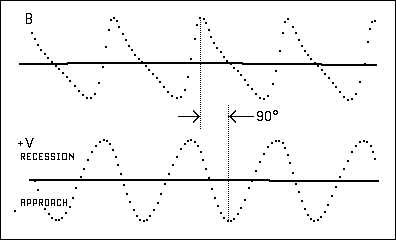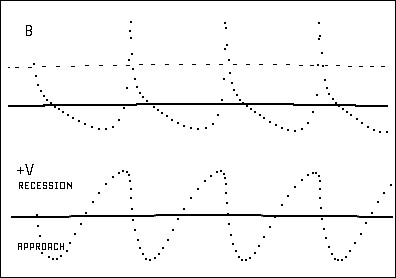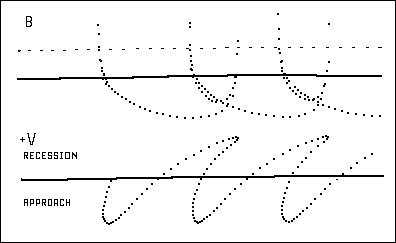|
I wrote a digital computer program called D-CEPHEI which simulates
Sekerin's scenario and got similar results, i.e., the 90 degree phase error
between the curves. The simulation uses an ellipse generator and at
selected points in the orbit the distance from a visible component to a
fixed observer is "measured." Then the computed source-to-observer travel
time, using either a constant speed of light or c + v is used to fill
arrival time bins (buckets). The accumulating sums in these bins are
scaled time-wise on the computer CRT screen. Doppler effects for
each "emission point" are used to create accompanying . . . radial
velocity curves. When two and a half orbits have been completed the
program stops the run and adds an "envelope" showing the final
summations of the arrival time bins. This envelope corresponds to what
we would observe in real-time.
Now, regarding the 90 degrees phase error, what sin of omission (or commission)
was being committed ... besides the basic heresy of using c + v?
Both computer models used Doppler shift computations to generate the radial
velocity variations curve.
Currently, Cepheids are said to be expanding and contracting, and
the variations of their radii account for the apparent radial velocity variations.
When they are expanding, we get approaching Doppler effects, and when
they are contracting, we get recessional Doppler effects. Sekerin's hypothesis,
in contrast, says that the apparent radial velocity variations are due to orbital
Doppler effects of a binary component (in a non-extinction environment), but
his curves suffer the 90 degree phase error. This phasing error, if not resolved,
would invalidate his thesis.
Time passed. . . . In 1991 I was explaining Sekerin's Doppler phasing dilemma to
James Mallet, a British entomologist. His totally unexpected response
(with regard to a genuine c + v environment) was, "But there'd be no
Doppler."
I made several mis-starts at trying to refute Mallet's contention but
eventually was forced into silence. He was right! (At least, in part.) For a
non-accelerating light source
which is moving toward or away from a given observer in a c + v
arena, the observer would not detect a Doppler related wavelength
change, but the observed frequency would be changed by
a factor of (1 + v/c) when approaching, or by (1 - v/c)
when receding, but the wavelength would remain constant.
[Repaired 14, 16 Dec 2009.]
Top
Ritz expressed this idea (about the unchanged wavelengths)* by saying that
a material point (or a star in our case) moving at a constant speed emits
concentric spherical wave fronts, each of which is centered on the source
at its latest position. There is no bunching up of wavefronts in the forward
hemisphere and no spreading out of those behind.
* See Ref (1), pp 209-210 and the
related Light Motion Animations. [Second link
added 14 Dec 2009.]
(Earlier versions of this article described an algorithm that used my erroneous
idea about orbital accelerations with respect to the observer as a means to produce
a properly phased apparent-radial-velocity curve. What follows is a first stab
to clean up the reasoning.)
For a binary star in a genuine c+v environment, observed frequency
variations can be caused by the same information arrival-time-modulation
that is hypothesized to cause the observed brightness variations. For
observed frequencies, we have
fo = fs / (dτ/dt), where fo
represents the observed frequency, fs is the raw (unshifted) source
frequency, and dτ/dt represents the differential of information
arrival-times versus real-time. Here, τ refers to Ritzian
relativity modulated light arrival-times (which will be temporally aberrant) and
t refers to real time. [Last sentence added 16 Dec 2009.]
For a non-accelerating source with respect to a given observer,
dτ/dt = 1. [Added 31 Jan 2006]
I replaced D-CEPHEI's algorithm which computes apparent-radial-velocity based on
orbital accelerations with respect to the observer with one which
uses the arrival-time-modulation factor dτ/dt.
Since this temporal Ritzian aberration of observed frequency fo is
not a Doppler effect, it should be given a name which cannot be confused with ideas
associated with existing terminology. For now the phrase time modulation
will be used. [This paragraph was added on 28 October 2002.]
For "local" binary-to-observer distances (less than 1.0 x 10exp-5 times the de Sitter
overtaking distance L) the time modulation variations turn out to be equivalent
to orbital Doppler effects. If the de Sitter overtaking distance happens
to be 85 light years, then the 1.0 x 10exp-5 L fraction corresponds to approximately five
astronomical units. At greater distances the time modulation effect begins to
produce time-wise compressions of information when the component of
concern is passing through its furthest point from the observer, and a stretching-out
of information when the component is passing through the closest distance to the
observer. These compressions and rarefactions produce frequency shifts that are more-or-less
in-step with orbital accelerations with respect to the observer. Time-wise they precede typical
Doppler effects by 90 degrees. [This paragraph was re-worked on 28 October 2002.]
At about 3.0 x 10exp-5 times the overtaking distance (16 AU for L= 85 LY) the 90 degrees
leading time modulation effect equals that of the Doppler-like effect. (A combination
of the shifts leads to an overall 45 degrees leading phase shift compared to
Doppler alone.) Beyond 1.0 x 10exp-4 times the overtaking distance (54 AU for
L= 85 LY) the time modulation acceleration-like effect dominates.
As the binary-to-observer distance reaches and exceeds the de Sitter overtaking
distance, the intensity and time modulation curves come to display time-reversals with
line doubling bounded by infinite-frequency excursions.
(See figures 8 and 10 below.)
This linear relation between source-to-observer distance and the
acceleration-like effects of the dτ/dt factor is reminiscent of
Weber's 1846 electrodynamic expression for the forces that single electrical
charges exert on each another as functions of their distances, accelerations
and velocities with respect to one another. The following equation
approximates Weber's expression. (I have used a plus/minus sign (instead of
his minus sign) preceding the velocity squared term.)

In the mks system the constant ñ would be
 . .
I confess that the velocity squared quantity above causes me grief and that
more digging into this old expression is in order.
At about .00003 times the overtaking distance (16 AU for L= 85 LY) the
time modulation 90 degrees leading effect equals that of the Doppler-like effect.
Beyond .0001 times the overtaking distance (54 AU for L= 85 LY) the
acceleration-like effect predominates. As the binary-to-observer distance reaches and
exceeds the de Sitter overtaking distance, the intensity and time modulation curves
come to display time-reversals with line doubling bracketed by
infinite-frequency excursions. (See figures 8 and 10 below.)
I digress at this point to call attention to Einstein's view on this business.
The following passage is borrowed from the last paragraph of
Section 2.10 of
Keven Brown's Reflections on Relativity.
Robert Shankland recalled Einstein telling him (in 1950) that he had
himself considered an emission theory of light, similar to Ritz's theory,
during the years before 1905, but he abandoned it
because he could think of no form of differential equation which could
have solutions representing waves
whose velocity depended on the motion of the source. In this case the
emission theory would lead to phase
relations such that the propagated light would be all badly "mixed up"
and might even "back up on itself". . .
For an example of this badly "mixed up" light in action, see the
Elliptical-Path Ritzian Binary Animations
simulation.
1 -
2 -
3 -
4 -
Next
|



